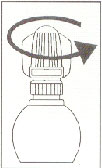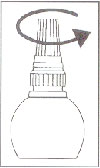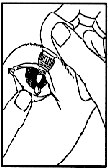50 micrograms/ml (0.005%) eye drops
latanoprost
What Xalatan is and what it is used for
Xalatan belongs to the prostaglandin analog drug group and lowers elevated eye pressure by increasing the natural outflow of fluid from the inside of the eye and out into the blood.
Xalatan is used to treat glaucoma ( open-angle glaucoma ) and ocular hypertension ( glaucoma ). Both of these diseases cause increased pressure in the eye that can eventually affect vision.
Xalatan is also used to lower elevated eye pressure and treat glaucoma in infants and children of all ages.
The latanoprost contained in Xalatan may also be approved to treat other conditions not mentioned in this product information. Ask your doctor, pharmacist, or other healthcare professional if you have any further questions, and always follow their instructions.
What you need to know before you use Xalatan
Do not use Xalatan
Xalatan can be used by adults (including the elderly) and children from birth up to 18 years of age. Xalatan has not been tested in premature babies (born before 36 weeks).
Do not use Xalatan
- if you are allergic to latanoprost or any of the other ingredients of this medicine (listed in section 6).
Warnings and precautions
Talk to your doctor or pharmacist before using Xalatan:
- if you are about to undergo or have just undergone eye surgery (including cataract surgery).
- if you suffer from eye problems (such as eye pain, irritation or inflammation, or blurred vision).
- if you know you suffer from dry eyes.
- if you have severe asthma or uncontrolled asthma.
- if you are pregnant or trying to become pregnant. Always consult a doctor before using Xalatan during pregnancy.
- if you use contact lenses, you can still use Xalatan, but then follow the special instructions in section 3.
- if you have had or are suffering from a viral infection of the eye caused by the herpes simplex virus.
Other medicines and Xalatan
Tell your doctor or pharmacist if you are taking, have recently taken, or might take any other medicines, including other eye drops.
If other eye drops than Xalatan are used, the eye drops should be given at an interval of at least 5 minutes.
Pregnancy and breastfeeding
Experience with use during pregnancy is lacking. If you are pregnant or breastfeeding, think you may be pregnant, or are planning to have a baby, ask your doctor or pharmacist for advice before using this medicine.
Do not use Xalatan if you are breastfeeding.
Driving ability and use of machinery
When you take Xalatan, you may experience blurred vision for a short time. If this happens, do not drive or use tools or machines until your vision is clear again.
You are responsible for assessing whether you are fit to drive a motor vehicle or perform work that requires increased attention. One of the factors that can affect your ability in these respects is the use of drugs due to their effects and/or side effects. A description of these effects and side effects can be found in other sections. Read all the information in this leaflet for guidance. Discuss with a doctor or pharmacist if you are unsure.
Xalatan contains benzalkonium chloride
This medicine contains 0.2 mg of benzalkonium chloride per ml. Benzalkonium chloride can be absorbed by soft contact lenses and can discolor the contact lenses. Remove contact lenses before using the medicine and wait at least 15 minutes before putting them back in. See instructions for contact lens users under section 3.
Benzalkonium chloride can irritate the eyes, especially if you have dry eyes or problems with the cornea (the clear membrane at the front of the eye). If you feel irritation, tingling, or pain in the eye after using the medicine, consult a doctor.
Xalatan contains phosphate buffer
This medicinal product contains 7.7 mg of sodium dihydrogen phosphate monohydrate and 1.55 mg of anhydrous disodium phosphate per ml. If you have a severely damaged cornea, phosphate can in very rare cases cause cloudy spots on the cornea due to the accumulation of calcium during treatment.
How to use Xalatan
Always use this medicine as directed by your doctor or pharmacist. Ask your doctor or pharmacist if you are unsure.
The usual dosage for adults (including the elderly) and children is one drop daily in the affected eye(s). It is best to dose in the evening.
Do not use Xalatan more than once a day because the effect of the treatment may be reduced if it is dosed more often.
Use Xalatan as directed by your doctor until your doctor tells you to stop treatment.
For those who wear contact lenses
If you wear contact lenses, they should be removed before dosing with Xalatan. After taking Xalatan, wait 15 minutes before putting contact lenses in your eyes.
Instructions for use



Instructions for use
1. Wash your hands and sit or stand comfortably.
2. Turn off the protective cap with “wings”.
3. Unscrew the cap.
4. Pull down the lower eyelid of the eye to be treated with a finger.
5. Place the tip of the bottle near the eye. Avoid the tip of the bottle coming into contact with the eye.
6. Press gently so that only one drop enters the eye and then releases the lower eyelid.
7. Press a finger against the inner corner of the eye, close your eyes and hold for 1 minute.
8. Repeat the dosage in the other eye if it is according to your doctor’s prescription.
9. Screw the cap on the bottle after use and place the bottle in the outer carton.
If you take Xalatan and other eye drops
Wait at least 5 minutes between dosing one with Xalatan and another eye drop treatment.
If you have taken too much Xalatan
If you have taken too many drops in the eye, a slight irritation in the eye may be experienced and the eyes may start to run and redden. The reaction should be transient but if you are concerned, consult a doctor for advice.
If you have ingested too much medicine or if, for example, If a child has ingested the medicine by mistake, immediately contact a doctor or hospital for an assessment of the risk and advice.
If you forget to take Xalatan
Continue with the usual dosage at the usual time. Do not take a double dose to make up for a missed dose. If you are unsure, consult a doctor or pharmacist.
If you stop taking Xalatan
Talk to your doctor if you want to stop taking Xalatan.
If you have any further questions about this medicine, ask your doctor or pharmacist.
Possible side effects
Like all medicines, this medicine can cause side effects, although not everybody gets them.
Side effects that are more common in children compared to adults are runny and itchy nose and fever.
Very common (may affect more than 1 in 10 users):
- Eye irritation (burning, grittiness, itching, stinging, or sensation of a foreign particle in the eye)
- A gradual change in the eyelashes around the treated eye (darker, longer, thicker, and more eyelashes )
- Redness of the whites of the eyes
- A gradual change in eye color through an increasing amount of brown pigment in the colored part of the eye called the iris. If you have a mixed eye color (blue-brown, gray-brown, yellow-brown, or green-brown), the color change is more likely to occur than if you have eyes of one color (blue, gray, green, or brown eyes). The change in eye color can take several years, but it normally occurs within 8 months after starting treatment. The color change may be permanent and may be more obvious if you use Xalatan in only one eye. No eye problems have been detected due to the color change. The change in eye color does not continue after treatment with Xalatan is stopped.
Common (may affect more than 1 in 100, but less than 1 in 10 users):
- Eye pain
- Eyelid inflammation ( blepharitis )
- Small point-shaped inflammations on the surface of the eye
Uncommon (may affect more than 1 in 1,000, but less than 1 in 100 users):
- Inflammation of the conjunctiva of the eye
- Swollen eyelids
- Inflamed or irritated eye surface ( keratitis )
- Dry eyes
- Blurred vision
- Chest pain
- Rash
- Nausea
- Vomiting
Rare (may affect more than 1 in 10,000, but less than 1 in 1,000 users):
- Swelling of the retina (macular edema), including blurred vision due to swelling of the retina (cystoid macular edema)
- Inflammation of the iris, the colored part of the eye (iritis/uveitis)
- Swelling of the cornea of the eye
- Abrasion on the surface of the eye
- Swelling around the eye
- Misdirected eyelashes are
- Abnormal hair growth on the eyelids
- Darker skin around the eyes
- Skin reactions on the eyelids
- Asthma
- Worsening asthma or sudden asthma attacks
- Labored breathing ( dyspnea )
- Itching
Very rare (may affect up to 1 in 10,000 patients):
- Chest pain
- Worsening chest pain in patients with angina pectoris
Has been reported (occurring in an unknown number of users):
- Corneal inflammation (herpetic keratitis )
- Headache
- Dizziness
- Sunken eyes (deepening of the furrow)
- A cyst (fluid-filled bladder) in the iris
- Small blisters on the conjunctiva
- Light sensitivity
- Palpitation
- Muscle and joint pain
If you get eye irritation that is so severe that your eyes water profusely or that makes you want to stop taking this medicine, talk to your doctor, pharmacist, or nurse straight away (within one week). Your treatment may need to be re-evaluated to ensure you are still receiving the right treatment for your disease.
In very rare cases, some patients with severe damage to the thin, clear membrane at the front of the eye (cornea) have developed cloudy spots on the cornea due to calcium deposits during treatment with phosphate-containing eye drops.
How to store Xalatan
Keep this medicine out of the sight and reach of children.
Use before the expiry date stated on the carton and bottle after EXP. The expiration date is the last day of the specified month.
Store at a maximum of 25 °C.
The opened bottle must be used within 4 weeks. When you are not using Xalatan, the bottle should be stored in the outer carton, so that it is protected from light.
Medicines must not be thrown into the drain or among the household waste. Ask the pharmacist how to dispose of medicines that are no longer used. These measures will help to protect the environment.
Contents of the packaging and other information
Contents declaration
The active substance is latanoprost 50 micrograms/ml (0.005%).
The other ingredients are benzalkonium chloride (0.2 mg/ml), sodium chloride (4.10 mg/ml), sodium dihydrogen phosphate monohydrate (E339i) (7.7 mg/ml) and disodium phosphate anhydrous (E339ii) (1.55 mg/ml), water for injections.
Appearance and package sizes of the medicine
Xalatan eye drops are a clear and colorless solution in a bottle.
Xalatan is available in pack sizes of 1 or 3 bottles in a carton. Each bottle of Xalatan has its carton. Each bottle contains 2.5 ml of Xalatan eye drop solution.
Not all pack sizes may be marketed.
Marketing Authorisation Holder
Upjohn EESV
Rivium Westlaan 142
2909 LD Capelle aan den IJssel
Netherlands
Local Representative
Viatris AB
Box 23033
104 35 Stockholm
Manufacturer
Pfizer Manufacturing Belgium NV
Rijksweg 12
2870 Puurs
Belgium